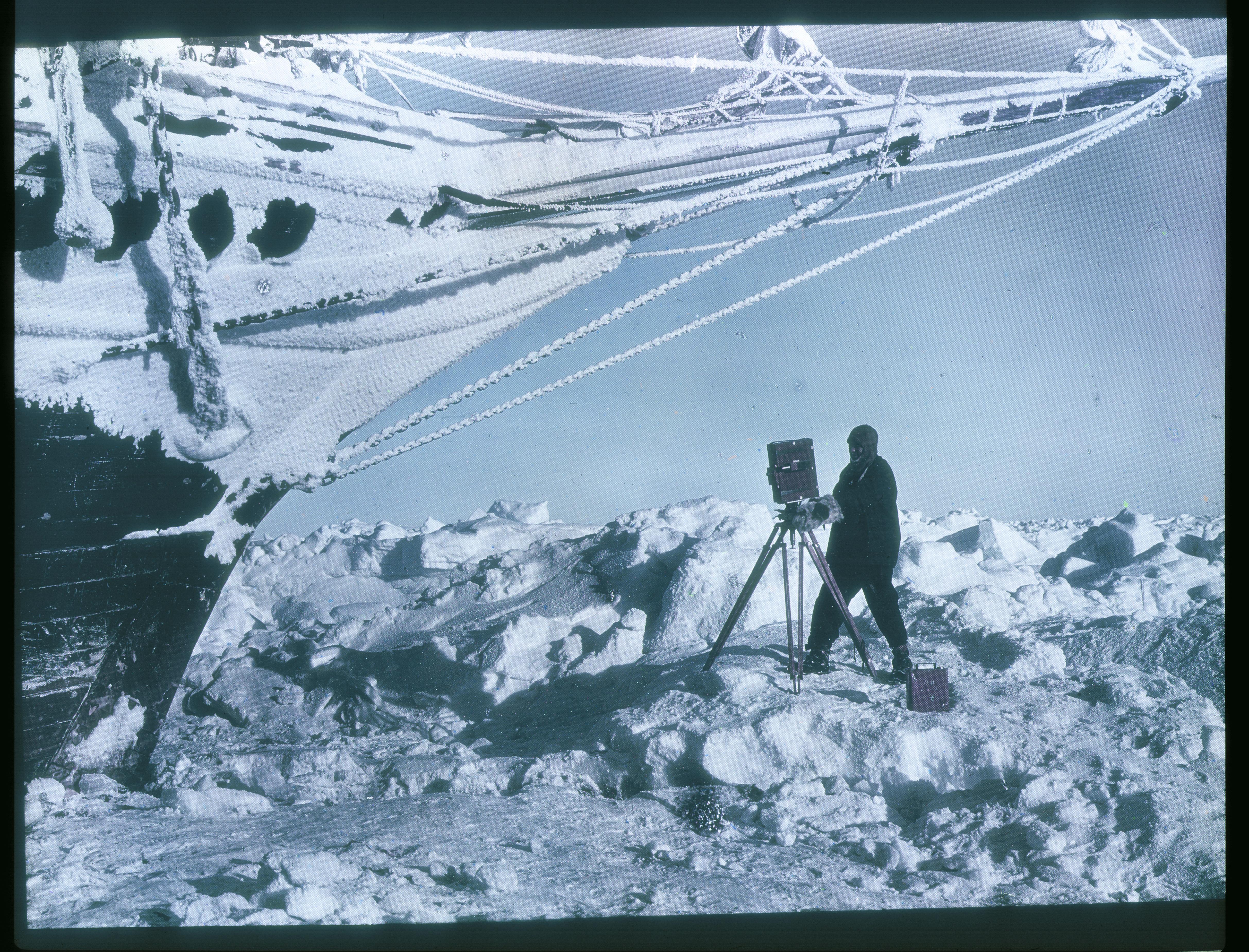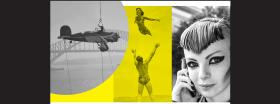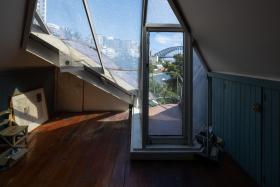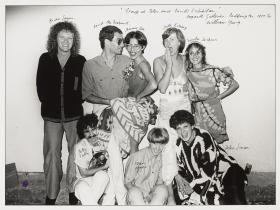The scope of this exhibition gives us an opportunity to look at the Library’s treasure trove of Australian photography — with close to 2 million photos it is one of the country’s largest collections, if not the largest. There are so many photos, we could re-mount this exhibition with completely new photographs every single year and it wouldn’t lose any of its significance. There’s no doubt that visitors would keep coming back too.
I’ve been working on this exhibition for more than a year. There is always lots of work across the entire curatorial team with acquisitions, events and so on, but getting the ok to focus entirely on the new Photography Gallery was the most wonderful thing for me. We’re always diving into the collection, finding something and thinking ‘oh wow’, before putting it back, hoping to find a use for it one day. So being given the time and being told ‘off you go’ is fabulous.
Our team’s remit was to stage the first extensive survey of the Library’s renowned photographic collection. It’s a grid-based, open display, which means there will be no visible captioning. Instead, visitors will view captions on digital kiosks. But with such a large collection, the immediate challenge is not what to use, but what not to use. So, we had to set parameters.
At first, we thought we could divide it by format or by subject area. But it soon became clear that this approach didn’t give an overview of the collection; we were just selecting things and putting them into pots. So, we decided to set rules to make us less subjective about our choices.
It would be chronological.
We would try and find a photograph for every year between the earliest-known photograph to survive in Australia, taken in 1845 and held in the Library, through to 2022. This approach has worked. There are some periods where it drops off, around the 1880s, for example. But having set the condition where we had a photograph for every year meant that particular photographers — or collections — won’t dominate the exhibition as they might have otherwise.
Something I hadn’t really appreciated until we’d put it all together was that we had created a strange pictorial history of Australia, which evolves in what feels like real time. With the building of the Sydney Opera House, for example, over 10 years or so you see photographs showing various stages of completion and each one feels fresh.
It would include as many photographers as possible.
We didn’t want to just focus on the famous photos but tried to include as many as we could, and be as gender diverse as possible. Not easy in the early years, but towards the latter part, perhaps surprisingly, a diverse range of photographers emerged that we didn’t even realise we had in the collection. Of course, we had to have some iconic ones — there are some things in the collection we just had to have. The Sunbaker by Max Dupain is one example.
We would try and include contemporary photographers’ own stories about the photos in captions when we could.
I find that a photographer’s words can connect me to the photo. Sometimes a photo can be like a window, and you feel yourself being objective as you peer through it. But hearing the photographer’s voice as well adds another more emotive dimension.
Award-winning photographer Matthew Abbott’s iconic image of a kangaroo running from the bushfires at Lake Conjola, for example, prompted him to write:
… when I approached Conjola, I saw unmatched mayhem.
I drove towards where they were fleeing. On the first road I came across, every house was burning. Further down the hill a little after 1 pm, I saw a group of kangaroos coming up the middle of the road, obviously running from another fire. One kangaroo ran right between myself and the burning house. I was able to make several frames of the frightened animal as it dashed past and then hopped away, safe at least for the moment.
We tried to include as many formats as we could.
Some of the Library’s larger collections are made up entirely of photographic negatives. You obviously can’t display photographic negatives easily. So, the solution we’ve come up with is to include a few examples of negatives with their own illumination to give viewers an idea of what they’re seeing, as with the Frank Hurley Paget plates from Antarctica. But most will be exhibited as prints. It’s the same with digital-born material, which we didn’t want to display on a screen, so we’ll be printing these as well. Everything will be displayed in a big open-plan grid style, broken into decades.
So it’s not about formats, it’s not about a subject, it’s not about a photographer — it could be anything. This allows the collection to tell its own complex story.
Until you get all the images together, you’re working on each item one by one. As curators, we’re lucky to work with objects. If you’re a researcher, you tend to approach from the subject. In other words, ‘I’m going to write about this thing,’ and then you find the material to do that. We find the objects, write about them and, as we put them all together, we start to get a broader perspective.
We’ve tried to vary the captions as much as possible. With so many objects to display, we can allocate only about 80–100 words for each photo. By the time we finished, we had 40,000 words describing this eclectic pictorial history of Australia.
At this scale you start to see themes repeat. One is First Nations content. We talked through portrayals of First Nations people with our Indigenous Engagement team, hoping to select images that don’t project a consistently negative view. While we found suitable material from most decades, it became more difficult as we went back in time. Most nineteenth-century photos are clearly lacking in empathy, but I guess this is a statement in itself. So, visitors to the exhibition will see First Nations people all the way through, but not grouped together.
The theme of war recurs often in the exhibition. The first example is from 1899, when NSW troops left for the Boer War. Moving to World War I, we have an amazing booklet by Frederick Burnell. It’s just a little exercise book but it is full of photographs he took when the first Australian troops went to seize German New Guinea. Burnell, a journalist, ended up writing a book about the episode, Australia’s first engagement in the war. This little booklet includes photographs of William Williams, the first soldier from the Australian forces to die during World War I.
We’ve also got photographs from the Gallipoli landing at Anzac Cove. I guess people were more preoccupied with other things, so there are not many photos of the dawn landing on 25 April 1915. The picture we have selected is a slightly blurry action shot showing the troops landing that first morning. Also, we’ve got a wonderful album of photos documenting the work of the doctors and nurses looking after the wounded at the Australian army hospital on the island of Lemnos, across from Gallipoli. It is an example of how the breadth of our collection offers different views of the war.
There’s a rare photograph of William Mulready, the youngest Australian to leave with the first contingent of the Light Horse Regiment in December 1914, sitting down after the Battle of Romani in Egypt in 1916. In his diaries, which the Library holds, he describes his engagement at Romani almost like a Boys' Own story. In the exhibition — and this relates to presenting images in their original formats — people may be surprised to see the original print is a tiny little thing. The importance of something doesn’t necessarily equate to size or scale.
The years 1938 and 1945 had an abundance of great photos, but even in lean years, there was usually something. There were some years during the 1970s where we seemed to acquire lots of photos of public figures opening schools and other institutions. They’re kind of interesting, but having accumulated a body of photographs, you have to match the standard that they set when you’re looking for more. That spurred us on.
We had a few challenges with the 1890s, but of course the really big problem area was the 1840s because there isn’t a lot of photography that has survived from then. Although the Library has some really great 1840s images — including the earliest surviving photograph, an 1845 portrait — we worried that putting too many portraits around it might undersell the first one. So we’ve just left that one as representative of 1845.
I guess I have a few sentimental favourites.
The exhibition will be up for a year. Usually we would do a changeover during that period, but we’re putting our best foot forward and showing everything we can, so we want as many people as possible to see it.
The centrepiece of the new gallery will be the original glass-plate negatives of the Holtermann Panorama of Sydney, from 1875, 9 metres in length and one of the treasures of the Library. These mammoth negatives will be displayed for the first time. Each big plate will be built into a large perspex display case that our conservation department has developed with specialised lighting, so they can be on display for the entirety of the exhibition. We looked at doing copies, but the actual negatives themselves are so amazing. We’ll have a kiosk alongside it so people can see the panorama in positive and will be able to zoom into it. The plates are really big, about 50 by 48 centimetres each, so if you compare it to a scan of a modern 35mm photographic negative, you can imagine the incredible level of detail held in these nineteenth century plates.
Most of the Library’s photographs have been acquired for their documentary value rather than for their artistic or aesthetic value, but this exhibition acknowledges and celebrates the artistry of many commercial, amateur and street photographers. When visitors look at these photographs they will realise that often there’s not much between them and art photography. This rationale informed our decision to show originals; exhibition prints are often done at a larger size and framed to look a particular way, but in this exhibition you’ll be seeing the prints as they were made. Sometimes they’re just contact prints, reference prints or prints put into albums to share with family members.
That’s another reason we decided to move away from the idea of framing all the pictures for an ‘art hang’. The exhibition’s grids are very much about showing the pictures as they are.
If they’re negatives, we print them as positives but we’re not trying to make them look like artworks. We’re not doing extra work on them. So, if they’ve got visible sprocket holes, for example, that’s how we reproduce them. Sometimes there is a little bit of touching up, but as a general rule we’re trying to leave it as an inversion of the negative as much as we can.
Our 3D exhibition designer Jemima Woo has done a fantastic job to create interest and variation in all of these grids, so visitors can get an idea of the diversity of formats and subjects. The majority of photographs are black and white, but arranging things chronologically means there are some surprises. Colour starts in earnest from the 1980s and now almost everything is colour. There are sporadic bits of colour going back to the 1950s, but then it goes to black and white, although some prints are sepia-toned. Going further back into the early period of photography, colour makes a surprising appearance with a variety of hand-coloured ambrotypes and prints.
I guess I have a few sentimental favourites. I’ve been overwhelmed by ACP photographers Norman Herfort, Alec Iverson and Ray Olson. They are consummate press photographers and many of their photographs are gobsmacking. So, for example, there’s a 1944 photo of Linda Malden working on a windmill at Spring Ridge (see right) and a 1945 photo of painter Stan Giddens walking up the Harbour Bridge (below). The photographers were sent along to cover those events as part of their everyday jobs. They produced stunning images, partly because they were given access to extraordinary people and circumstances.
This exhibition launches the Library’s first dedicated photographic gallery. It’s an important addition to Sydney’s cultural spaces because there are very few institutional galleries devoted to photography that have the scope of this one.










